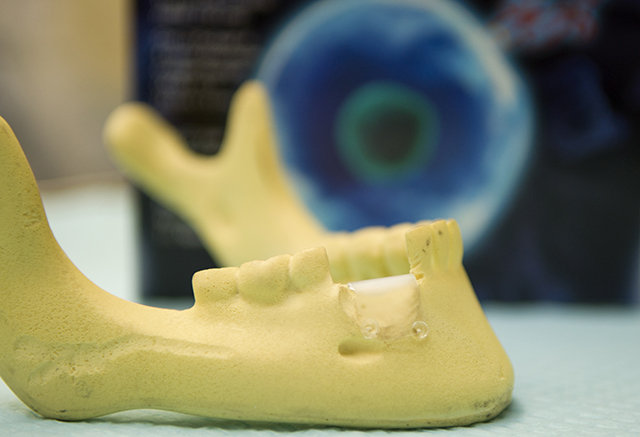Regenerating bone to anchor dental implants

A new method for producing localized bone growth is a promising option for patients with bone loss who are considering dental implant surgery.
For patients who need dental implants, the process can seem especially daunting if they also need additional bone to support them. Previously this meant a separate surgery to acquire this bone through a graft from the patient’s jaw or hip and reposition it at the implant site.
Thanks to a clinical inspiration by Dr. Marianela Gonzalez, assistant professor of oral and maxillofacial surgery at Texas A&M University Baylor College of Dentistry, patients now have an alternative.
The award-winning treatment idea was sparked through caring for a patient who had lower teeth so loose that extraction was required. Localized bone loss was to blame, and Gonzalez knew that to prepare the patient to receive dental implants, she would need to recreate ample bone to provide a firm anchor.
“For an outcome that works with implants, you need plenty of three-dimensional volume with the new bone,” Gonzalez says. “The problem with the previous bone graft method is that it tends to add only width but not height to the bone and fails more than half the time.”
Gonzalez conceived a new use for a product called Sonic Weld membrane as a potential solution. This resorbable material originally was used by surgeons to repair cranial fractures in children who, because of future bone growth, needed something less permanent than titanium plates for fracture repair. Sonic Weld also had manufacturer-suggested uses inside the mouth, but none leading to the results Gonzalez desired. She had another idea.
Gonzalez attaches the membrane over the top of the gums to create a pocket of space over the area where bone is needed. She then fills the space with Infuse Bone Graft, a protein that binds with existing bone cells and attracts the cells to create bone. Because it can be reabsorbed into the tissue, Sonic Weld is an enticing alternative to methods that use titanium mesh, which require bone grafts and secondary surgeries to remove.
“By using SonicWeld membrane with the Infuse Bone Graft to create bone growth, we got excellent results, and we ultimately placed implants and crowns,” Gonzalez says.
Gonzalez has repeated the technique on several patients, now at varying stages of the implant process. In all cases, she found that within four to six months, the adaptable membrane filled with the protein formed bone with the desired height and width to create an environment suitable for implants.
“Not only does this technique give the patient new teeth, we have a better cosmetic result because it produces extra soft tissue,” says Gonzalez. “This enhances the appearance of the crown attached to the implant because it is surrounded by natural gum tissue.”
Gonzalez and several department faculty members submitted their findings to the Academy of Osseointegration Case Study Poster Competition in March, which occurs during the annual meeting of this international association for dental implant professionals. They won first place among 225 submitted posters.
The team followed up with a presentation in April to the American College of Oral and Maxillofacial Surgeons, and a manuscript will be submitted for publication. Gonzalez reports the new procedure has been met with much interest from professional colleagues.
“It’s exciting because patients can finally have an alternative,” Gonzalez says. “Instead of going to the operating room and taking bone from the jaw or hip, we can recreate bone and be able to place implants, and patients can look natural and have complete function.
“We have a four-year follow up on the first patient treated with this procedure, and he is doing great in terms of bone, implants and crown stability.”